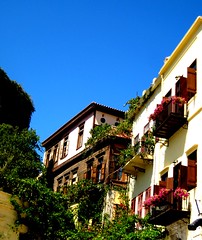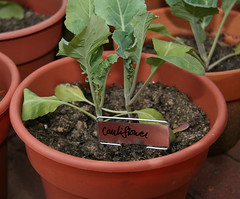| Balcony (Photo credit: sez9) |
Almost anything can be used as a container – old plastic jugs, watering cans, bowls, canisters – just as long as you can create a drainage hole near the bottom so the pot won't get waterlogged and rot the roots of the plant. But you can also buy a wide range of terracotta and other gardening containers at nurseries and in department stores.
Many garden centers will provide good organic potting soil as well. Or if you wish to use your own, you might acquire dirt from somewhere else, and mix it with sand and compost. (The ratio would be equal parts of each.) Mixing in a little peat moss and organic perlite will both help the soil absorb water, yet allow the excess to drain. If you make sure the soil is well watered before your plants go in, you'll give your plants a good head start.
As to your choice of plants, most annuals will do quite well in containers. Some can even be grown indoors during the cooler months. Be sure you have enough room for the plants' roots to grow; don't place something huge in a tiny container, unless you've done your research and know that this particular plant likes having its roots all cramped up.
For vegetables, you will likely need about six hours a day of sunlight, so you want to place their pots in the right location on the balcony. Again you'll need to do some research about which vegetables work best in which pots, but some things will simply make sense. For example, carrots would need planting in quite a deep pot. Tomatoes and peppers do especially well in containers. And you could have an entire large pot – or several – stuffed with different kinds of herbs or salad greens.
| Container Garden! (Photo credit: LollyKnit) |
Container plants can often be kept clear of insects more easily than garden plants: you can bring the whole container inside, put it in your sink, and spray it with either an organic pest spray or one you've made yourself. This would involve mixing 40 parts water with one part of non-detergent soap (such as Ivory), and spraying it on the undersides of the leaves as well as other places where the insects are. Then after a few moments, you would spray it clean again.
Deadheading flowers when the blooms are finished, and keeping both the pots and the balcony itself clean of dead vegetative matter will also help keep the plants free of insects.
As you can see, many of the same methods used in an organic garden in the yard will apply to an organic container garden as well. If you've got a sunny balcony or patio, there's no reason why you shouldn't enjoy an organic garden just as much as someone with a big garden space.
Helpful Container Gardening Resources:



No comments:
Post a Comment